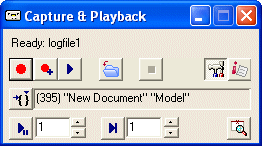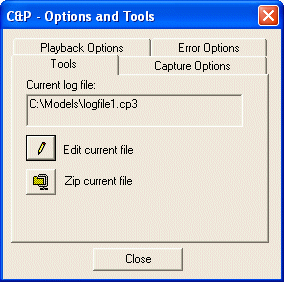 Capture & Playback
Capture & PlaybackTools Capture & Playback Capture & Playback |
The Capture & Playback environment enables you to record (Capture) all the actions executed during an application working session into a log file and then execute them all again (Playback).
The following document describes general concepts about the Capture & Playback functionality:
Additional information about recording and playing back sessions can be found in the following documents:
| Log files compatibility Due to changes within the program, the accuracy of the Playback of log files recorded using a previous versions of the application can not be ensured. |
When you start the Capture & Playback command, the Capture & Playback dialog box is displayed. Initially, the Playback buttons are unavailable (since you have not yet recorded a log file).

When you select the Record button to begin recording a work session, the program displays a file dialog box for saving the log file. To play back an existing log file, click the Open button to select the desired log file.
The Capture & Playback dialog box provides the following functions:
 |
Record | Starts a Capture session. The program displays a file dialog box in which you specify the location to save the new log file. Once you've specified the log file name, all the actions you perform are recorded to the log file, until you select the Stop command. (For more details click here) |
 |
Append Record | Starts a Capture session in append mode. All the actions you perform are appended to the selected log file, until you select the Stop command. (For more details click here) Before starting the recording session, an automatic Playback of the current log file is performed, so that the recording session starts at the end of the current log file. |
 |
Playback |
Plays back the current log file or the list of log files (the Play list having the file extension ".lst") until the end of the log file. If the Show trace option is active (read C&P - Options and Tools), a trace of the log file is printed to the I/O window, displaying each line being executed preceded by its own number, but the Playback session will be longer when this option is selected (for more details click here). |
 |
Open | Displays a file dialog box enabling you to select a log file for Playback. |
 |
Stop | Stops the current record/playback session. |
 |
Debug |
Expand the Capture & Playback dialog box to enable you to play back the current log file in step-by-step mode, using either context tags or log file line numbers. 
Read Debug mode for additional information about these options. |
 |
Options and Tools |
Displays the CP - Options and Tools dialog box, in which you can set the options which control the way the Capture & Playback functionality is performed. 
Read CP - Options and Tools for additional information about these functions. |
To avoid potential problems, you have to keep the following information in mind when using the Capture & Playback functionality:
To ensure the portability of a log file and decrease the possibility of incorrect selections, adhere to the following rules:
| Performing Playback outside the Capture & Playback environment If you want to perform a Playback session outside the Capture & Playback environment, you should use the GPL function EK_PLAYBACK, present in the GPL library. Using this function (instead of the GPL PLAYBACK command) ensures that the initial parameter environment from the Capture session is correctly reproduced during the Playback session. The syntax is:
> EK_PLAYBACK(file,opt) where :
|
The log file is organized into sections. (Note that you can edit a log file by using the Edit current file  function, which opens the log file using the text editor program currently associated with ".txt" files).
function, which opens the log file using the text editor program currently associated with ".txt" files).
 2009.1.108.490' )
2009.1.108.490' ) \2009.1_480\
\2009.1_480\ \doc\samples
\doc\samplesThe Save As command is recorded this way:
<IDR_UITYPE*POPUP_CAT_FILE*ID_FILE_SAVE_AS>: ek_file_save(0)
: *IDR_FSBPLUS CFI 1
: *IDR_FSBPLUS DIR C:\models
: *IDR_FSBPLUS FILE block2.e3
Capture and Playback